From Selling Tea to Selling Japanesenss: The Rise of the Iemoto
Kristin Surak
Senior Lecturer in Japanese Politics
SOAS,, University of London
Iemoto: grand masters who host a tea ceremony and offer hospitality to official guests from abroad, including heads of state. Today, they are naturally considered to be the top of schools, but why and how did they come to possess the ultimate authority within their school and how did they become associated with politics or the state? And how did they come to be regarded as a symbol of Japanese culture?。
Kristin Surak, the former Japan Foundation Fellow for Japanese Studies, gave a presentation on the historical rise of the iemoto and their transformation, which she has been researching for more than 10 years.
(The presentation was made at JFIC Space "KEYAKI," The Japan Foundation on July 10, 2014)
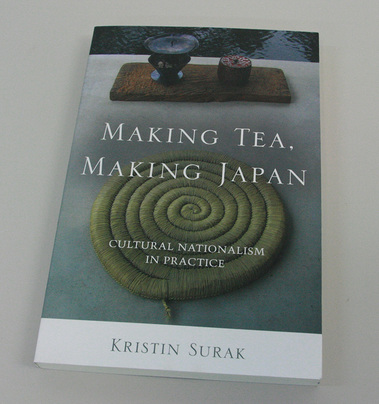
Few practices are simultaneously as exotic and representative, esoteric and quotidian, instrumental and sensual, political and cultural as the Japanese tea ceremony. While most Japanese have never participated in a formal tea gathering, and to many its arcane procedures remain rather alien, the practice is still recognized as a defining constituent of Japanese culture, integrating arts, manners, and sensibilities deemed peculiarly characteristic of the nation into a single, striking form. The tensions through which this emerged are the subject of this talk.
My research unpacks this seemingly natural link between tea ceremony and Japaneseness - that is, how it was established historically, how it has become central to the organizational structure of the tea world, how it is embodied in the physical enactment of the practice, and how tea practitioners invoke Japaneseness in actual tea performances. Today, I focus on the role of the iemoto system in Japan.
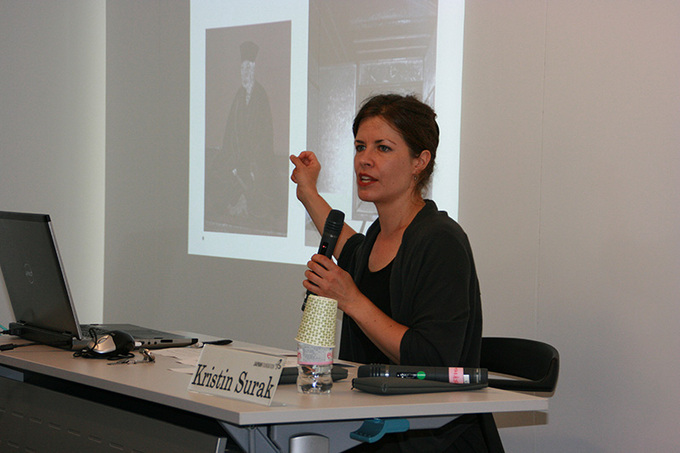
Daimyo- and Merchant-style Tea Ceremony
Of course for most of its history, the tea ceremony wasn't a particularly "Japanese" practice, but one largely representative of elite men. During the late sixteenth century, the archipelago witnessed both a remarkable political upheaval and aesthetic efflorescence. The two great warlords, Oda Nobunaga and Toyotomi Hideyoshi consolidated expanding zones of control over the country, and laid the bases of the new social order that would take shape under the Tokugawa Shogunate of the next century. Seeking legitimacy for their new-found grip on power, these warlords adopted the aesthetic practices of their aristocratic predecessors. Of these, tea became crucial. But they appropriated not only forms of aristocratic, but also merchant tea, which offered a means to win the favor of urban commercial establishments, particularly those trading in military supplies and key staples and metals - essential during this battle-riven time of territorial consolidation. Tea ceremony thus became a key political tool - tea utensils became war prizes, small tea gatherings functioned as networking opportunities, and large tea gatherings marked triumphal military victories. In this, merchants-cum-tea masters acted as intermediaries in negotiations off the battlefield, one of the most powerful of whom was Sen Rikyu, who became Hideyoshi's right-hand man.
While Rikyu took with more subdued aesthetic of wabi-tea to new levels of refinement, he also catered to Hideyoshi's ostentatious tastes - a trend continued by Rikyu's successor, Furuta Oribe, who promoted a glitzier karasuki aesthetic employing many ornate Chinese-origin utensils and using the social arrangements of the tea room to re-entrench rather than overcome social boundaries - characteristics desirable to the ruling daimyo class. Following Hideyoshi's death, the division between daimyo- and merchant-style tea ceremony became ingrained, with daimyo tea predominating at the heights of political power.
Still, merchant-style tea persisted. After Sen Rikyu's death, his grandson Sen Sotan continued and expanded his practice as a family concern by using Rikyu's name (transforming his forebear into the "tea saint") to establish a large network of tea associates and disciples. As was the case with other aesthetic pursuits of the time, he adopted the iemoto system to institutionalize his position. During this time when the household (the ie) was being written into law as the foundation of a status-defined society, the iemoto were both the heads of a particular school or style of aesthetic activity, and a particular family that has passed down the authority to define this style, which they then, in effect, sold to students purchasing lessons. In the case of tea, the Sen iemoto succeeded, not to Rikyu's innovative ingenuity or creative skill, but to a body of knowledge they defined and attributed to the master. Formalizing Rikyu's legacy and standardizing modes of preparation, the three branches of the Sen family reconfigured the diversity of tea practices into a codified field. They did this by extending their authority over the three critical domains of tea practice - preparation techniques, utensil values, and standards of taste.
In the case of techniques, the Sen family consolidated a body of expertise by developing a formal curriculum of tea preparation procedures that could be used to draw in new learners and sustain their interest over time. They formalized these exercises into a proficiency system with seven grades. By purchasing permission certificates, acolytes could gain access to the knowledge in the iemoto's keep, purportedly passed down from Rikyu. Authority was generated and extended not only over how people made tea, but also over the objects they used to make it. Whereas, in the sixteenth century, a spirit of creativity in using "found objects" - using, for example, a fishing basket as a flower vase - proliferated, by the early eighteenth century iemoto were certifying particular utensils as especially suited for tea, by literally adding their stamp of approval to the utensils themselves or the boxes containing them. They also began authenticating utensils - writing certificates for tea bowls and scoops that had apparently "lost" their pedigrees, guaranteeing that they had belonged to tea greats of the past. And, finally, they began taking control of their own stylistic canons themselves, by designing and producing utensils, thereby promoting an authorized aesthetic sense.
Thus by the end of the eighteenth century, the iemoto had accumulated a large measure of symbolic power over the tea ceremony, but, nonetheless, there were limits to their influence. Not only did they not have the infrastructure to completely ensure that distant practitioners continued to practice their merchant-style tea as it was dictated from the center, but their presence at the pinnacle of society was weak, where the iemoto-less daimyo-styles of tea preparation dominated.
Though in the Tokugawa Era, proficiency in the tea ceremony was a social skill any man of cultivation was expected to possess, when the Shogunate eventually collapsed in the 1860's, there was no guarantee that the practice would survive, let alone flourish, in the drastically altered conditions of Meiji Japan. The Sen iemoto were bankrupted, and the daimyo were dissolved. But the tea ceremony remained too deeply associated with the exercise of power to be discarded. Indeed, the ascendant capitalist elites taking over society's helm, adopted the cultured practices of prior rulers, in hopes of tempering their image as ravenous economic animals.
These businessmen - the heads of Mitsui, Mitsukoshi, the Tobu Railroad, and the like, along with numerous politicians - not only a spurred a thriving market for famous tea utensils, now being redefined as objects of art and treasures of the nation, but also their gala tea gatherings were attended by the powers-that-be and lavishly covered in the press. The iemoto-less tea they practiced had found a new carrier.
The immediate future of merchant-style tea, however, appeared grimmer. Bankrupted by the Meiji Restoration, the Sen families sought to forge ties to the new imperium by claiming that tea training provided a means for cultivating the Confucian values all good imperial subjects should now possess. As one iemoto declared, the true purpose of tea was to preserve the "national essence," and he argued that tea, as "the basis of national morals and national manners."
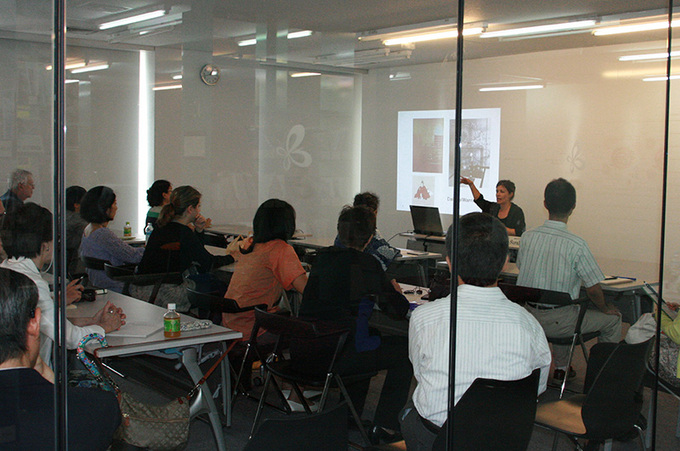
Iemoto's Survival and Spread of Tea Ceremony among Women
More crucial for the iemotos' immediate survival, though, was another social change. Under the Tokugawa, tea ceremony was the reserve of men. Under the former neo-feudal order, some women learned the practice as a form of etiquette training, but they were endowed with only a thin knowledge of the basic procedures, and no records indicate they hosted formal gatherings. Under the Meiji regime, however, women were not only increasingly liberated from status restrictions, but they were expected to contribute to the national polity of which they too were now part - even if a lesser one. From the 1890s, local educators at a number of girls' schools incorporated tea training as a part of the curriculum and extra-curriculum.
The iemoto quickly latched onto this trend not only donating utensils to girls' schools, but teaching classes at them as well. In the nation-making atmosphere of late Meiji, girls' home economics and etiquette textbooks increasingly emphasized the tea ceremony as part of the long and unique history of Japanese manners. Tea was described as essential to the "qualities of our country's women and of the ways of our country's people of the past," and proffered as a guidebook for the state-supported ideal of the "good wife and wise mother." The national image of the practice was further disseminated in school history textbooks, which generally included a section on Rikyu and tea practice during the glorious period of territorial consolidation under Nobunaga and Hideyoshi.
The iemoto benefited greatly from this tread, for young women were particularly well-suited to become a lucrative pool of customers. In particular, because they could make use of the iemoto's certifying authority beyond the tea world. Included as part of a dowry, iemoto-issued certificates imparted official assurance of a woman's worthiness as a wife. (The elite businessmen had little need for such external validation of what was, for them, largely aesthetic entertainment.).
But women remained, of course, second-class citizens, and down to the end of the Taisho period (1912-1926), the iemoto could not compete on the scale of tea prestige with the Captains of Industry collecting priceless utensils for their own free-form ceremonies. But the financial crisis of 1928 turned the tables, as the Robber Barons passed from the stage. Their financial and geriatric decline opened a space for maneuver, in a Showa Japan of escalating militarism and ultra-nationalism.
In the 1930s, a rising chauvinistic tide saw increasing official energies invested in defining the particularities of the Japanese, and the tea ceremony served a useful tool in these endeavors. In just one example, the Ministry of Education's Kokutai no Hongi (Cardinal Principles of the National Polity) of 1937 - which, with a circulation in the millions was must-reading for anyone in the school system, both on the archipelago and in the colonies - enrolled the wabi aesthetic of tea as a prime expression of the national spirit. It described, for example, that..."This spirit in which an impartial concordance is created, reversing the time-honored discrimination of rank and occupation, accordingly nurtures the spirit of selfless duty."
In this atmosphere, the iemoto were able to claim the limelight for themselves. The decade witnessed two national tea events commemorating the anniversaries of a grand tea gathering by Hideyoshi and Sen Rikyu's death. These mega-events - which drew over ten thousand attendees, were broadcast on national radio, and garnered extensive newspaper coverage -- placed the iemotos' tea preparation on display to the nation as the epitome of tea practice. In the news coverage, the iemoto wove their wares into a nationalist narrative, declaring that "in [the tea of] Rikyu...is a culture of wabi whose spiritual basis accords with the national essence of the Japanese people." These events were followed by a series of best sellers by academics and arm-chair intellectuals, rallying Rikyu's tea as a means to transmit a self-sacrificing militaristic nationalism to the populace.
But this did not last long. By 1945, imperial collapse and military occupation left the iemoto, as earlier at the fall of the Shogunate, once more in a potentially precarious position, exposed to attack as remnants of a discredited patriarchal tradition that had become adjuncts of an authoritarian order. Though over almost three centuries they had accumulated significant symbolic power, they had yet secured it as a routine attribute of their calling
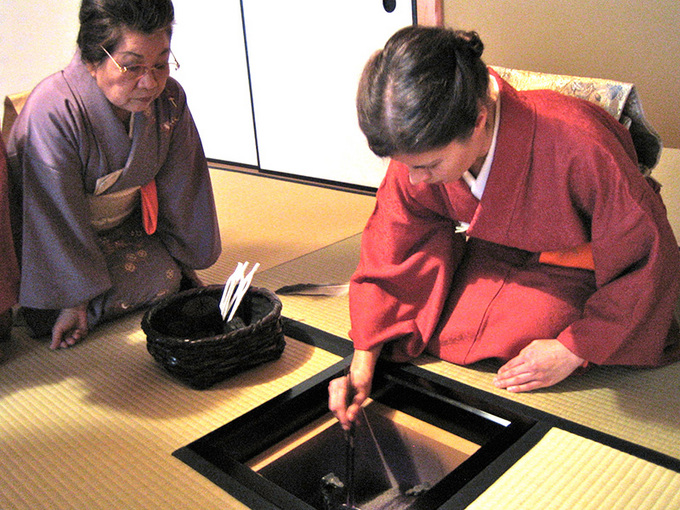
Synthesis of Tea Ceremony and Japanese Culture
Briefly, they were able to do so by refashioning their position in society in two complementary directions. Economically, they would convert themselves into modern business corporations, in syntony with the high-speed Japanese capitalism of the post-Occupation period. Socially, they would ascend to the status of cultural elites at a time when culture was one of the few legitimate arenas for nationalist expression. As the defeated Japan redefined itself as a peaceful "Country of Culture" (Bunka Kokka), the iemoto crafted new roles for themselves as cultural ambassadors, who use the tea ceremony, as a "synthesis of Japanese culture," to represent the country at the highest levels of international exchanges. (Indeed, the head of the dominant Sen family is Japan's actual Cultural Ambassador to the United Nations.)
This branding association could also serve as a pitch for marketing a new range of business endeavors. Traditionally, iemoto reaped their profits from the sale of tea certificates, classes, texts, and publications - what might termed "tea expertise." But from the mid-twentieth century onwards, they diversified their business interests by opening publishing houses, architectural firms, travel agencies, and even junior colleges, in what is now a half-billion dollar industry. As tea was elevated to the rank of overarching cultural synthesis, the iemoto claimed authority over not simply tea practice, but Japanese culture in general. Asserting that Japanese culture was succumbing to a host of modern ills, they marketed their books, dinner plates, language courses, and cruise ship tours as a means to recuperate its true essence.
Typical sales pitches run along these lines: "traditional Japanese ways of life are withering, " we need a "Japanese attitude to life of which we can be proud." Or, "In this confused society, the good taste of a Japanese life is being lost." The salve? "The tea ceremony, [which] can return society to its true abode." Symbolic escalation and market expansion went hand in hand.
The success of the iemoto in ensconcing themselves as the epitome of Japanese refinement is revealed in their post-war marriage patterns. One iemoto has secured a match with the Tokugawa family - a prospect inconceivable under the Bakufu - while another has married a cousin of the emperor, an imperial connection whose chance for mention is rarely missed. With yet more publicity, the pinnacles of elective office invariably pay homage to the iemoto. Every year, the incumbent Prime Minister and an entourage of top bureaucrats attend in the first week of the New Year, a celebratory tea preparation the main complex of one of the Sen branches Tokyo. This spectacle, relayed to the public by press and television, stages the continuity of the role of Japanese rulers in the practice of the ceremony since the time of Nobunaga and Hideyoshi, as well as the novelty of the status of the iemoto in presiding over it.
Little could better illustrate the passage of symbolic power from its accumulation to routine exercise.
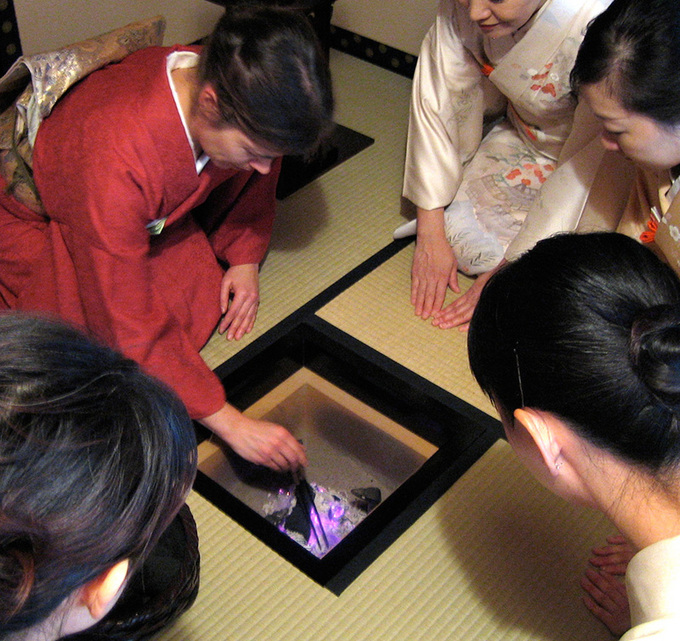
Conclusion
The Japaneseness of the tea ceremony, as a concentration of national meanings, has been captured and secured by the iemoto in a historical process of wider significance. In the first stage, the iemoto projected the authority to define and certify authentic tea onto single master figures - the iemoto. Grounding legitimacy in genealogical connections to Rikyu, the iemoto then transformed a variety of innovative tea practices into a body of formalized knowledge that could be inherited and controlled. Administrative mechanisms developed to enforce this authority, including the elaboration of a curriculum and certificate system, and the inception of standards of utensil value and taste, based on the iemoto's genealogical authority.
Throughout this period, the tea ceremony - though not the tea of the iemoto - was wedded to the apex of political power, state connections that facilitated its later nationalization. In the first phase of the accumulation of symbolic power, the main competitor to the iemoto was the warrior-style daimyo tea, which remained the variety of choice among the dominant classes through the Tokugawa, Meiji, and Taisho Periods. This shifted with the decline of its latter day carriers, the business elite, in the 1920s, and the subsequent mobilization of cultural activities for the war effort. This combination enabled the iemoto to start annexing associations between tea ceremony and the Japanese nation diffused through etiquette and history textbooks in the school system, as they began to represent themselves as the living embodiment of this pediment of Japanese culture.
But it was not until after the war that the political need for promoting Japan as a "Land of Culture" enabled the iemoto to become icons wielding symbolic power over not simply over tea practice, but Japanese culture in general, ensconcing themselves firmly among the country's elites. The iemoto could then employ a conflation of tea and Japanese culture to market new lines of product beyond their traditional base tea knowledge proper. At this point, a second stage has been completed, as symbolic power is exercised as a routinized practice.
While the tea ceremony is somewhat idiosyncratic, due to the concentration of power under the iemoto system, the mechanisms of authority accumulation and exercise are broadly generalizable. The elaboration of administrative techniques enables the constitution and regulation of a cultural field, print and broadcast media magnify its importance beyond the boundary of direct participants to broader society, elite networks aid in elevating symbolic status, and historical junctures can temper or facilitate these endeavors. These processes enable actors to lever a cultural practice into symbolic national status while transforming the cultural field itself by material investment in its national meanings.
Kristin Surak
Kristin Surak is a Senior Lecturer (Associate Professor) at the School of Oriental and African Studies, University of London, and the Japan Foundation Fellow for Japanese Studies from 2006 to 2007. Her research on topics international migration, culture, ethnicity, nationalism and other topics has been published in the European Journal of Sociology, International Migration Review, Ethnic and Racial Studies, Merkur, Lettre International, and New Left Review. In her book, Making Tea, Making Japan: Cultural Nationalism in Practice (Stanford University Press, 2013), she examines the relationship between cultural practices and national meanings by investigating how the tea ceremony serves as a symbol of Japan and won the Outstanding Book Award from the American Sociological Association's Asian Section.
Keywords
- Traditional Arts
- Cultural Heritage
- Arts/Contemporary Arts
- Politics
- Philosophy/Religion
- History
- Japan
- The School of Oriental and African Studies
- University of London
- Tea Ceremony
- iemoto
- Oda Nobunaga
- Toyotomi Hideyoshi
- Tokugawa Shogunate
- Sen no Rikyu
- wabi-tea
- Furata Oribe
- Sen Sotan
- Daimyo-style tea ceremony
- merchant-style tea ceremony
- Meiji
- Mitsui
- Mitsukoshi
- Tobu Railway
- Meiji Restoration
- etiquette
- Taisei
- Showa
Back Issues
- 2019.8. 6 Unraveling the Maker…
- 2018.8.30 Japanese Photography…
- 2017.6.19 Speaking of Soseki 1…
- 2017.4.12 Singing the Twilight…
- 2016.11. 1 Poetry? In Postwar J…
- 2016.7.29 The New Generation o…
- 2016.4.14 Pondering "Revitaliz…
- 2016.1.25 The Style of East As…
- 2015.9.30 Anime as (Particular…
- 2015.9. 1 The Return of a Chin…

